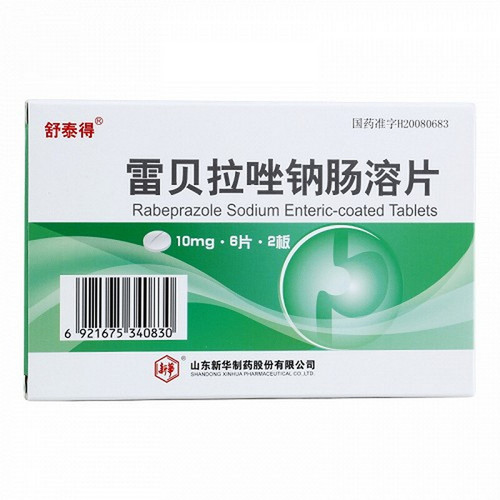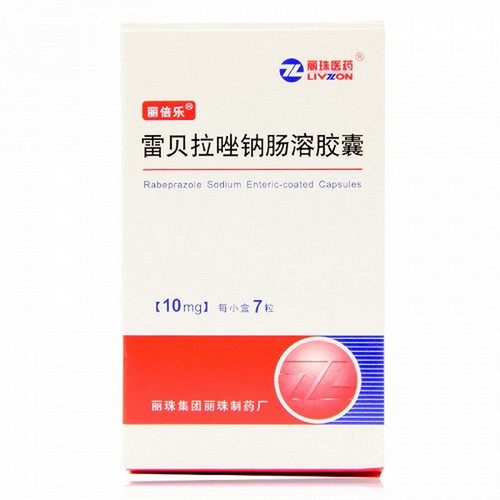Product Overview
[Drug Name]
Trade Name: Dingqier
English Name: Rabeprazole Sodium Enteric-coated Tablets
Chinese Pinyin: LeiBeiLaZuoNaChangRongPian
[Ingredients]
Rabeprazole sodium. Chemical Name: 2-{[4-(3-methoxypropoxy)-3-methylpyridin-2-yl]methanesulfinyl}-1H-benzimidazole sodium. Molecular Formula: C₁₈H₂₀N₃NaO₃S. Molecular Weight: 381.43
[Properties]
This product is a white enteric-coated tablet. After removing the coating, the tablet appears white or off-white.
[Indications]
This product is indicated for the treatment of the following: 1. Active duodenal ulcer; 2. Benign active gastric ulcer; 3. Symptomatic erosive or ulcerative gastroesophageal reflux disease (GORD); 4. In combination with appropriate antibiotics, it can eradicate Helicobacter pylori-positive duodenal ulcers; 5. Maintenance treatment of erosive or ulcerative gastroesophageal reflux disease. The efficacy of treatment beyond 12 months has not been evaluated.
[Dosage and Administration]
This tablet should not be chewed or crushed; it should be swallowed whole.
1. Dosage for Adults/Elderly Patients:
A. Active duodenal ulcers and active benign gastric ulcers: 20 mg (2 tablets), once daily, in the morning. Most patients with active duodenal ulcers resolve after 4 weeks of treatment. However, 2% of patients may require 4 more weeks of treatment to achieve resolution. Some patients with duodenal ulcers respond to a 10 mg tablet (one tablet) taken once daily in the morning. Most active benign gastric ulcers resolve after six weeks of treatment. However, 9% of patients require an additional six weeks of treatment to achieve resolution.
B. Patients with erosive or ulcerative gastroesophageal reflux disease (GORD): 20 mg (two tablets) once daily for 4 to 8 weeks.
C. Long-term treatment regimen for GORD: Maintenance therapy for 12 months at a dosage of 10 mg (one tablet) or 20 mg (two tablets) once daily. Some patients respond to a maintenance dose of 10 mg (one tablet) per day.
D. Curative treatment of Helicobacter pylori: Combined with appropriate antibiotics, it can cure H. pylori-positive duodenal ulcers. This product should be taken in the morning, before meals. Although the time of administration and food intake have no effect on the efficacy of rabeprazole sodium, this method of administration is more conducive to the treatment process.
2. Use in patients with hepatic and renal insufficiency: Patients with hepatic and renal insufficiency do not need to adjust the dosage during the medication process. However, when using this product in patients with severe hepatic insufficiency, please refer to "Adverse Reactions and Precautions".
[Adverse Reactions]
Reports in foreign literature: 1. Serious side effects: (1) Shock: There are reports that this product has side effects such as allergic reactions and shock. Therefore, if any abnormality is found, the product should be stopped immediately and properly handled. (2) Blood: This product rarely causes various blood cell reductions, thrombocytopenia, granulocytopenia, hemolytic anemia, etc. However, it can occasionally cause granulocytopenia, anemia, etc. If any abnormality is found, stop taking the product immediately and seek treatment. (3) Visual impairment: There are reports of visual impairment in foreign patients taking this drug. 2. The most common adverse reactions are headache, diarrhea and nausea. Other adverse reactions include rhinitis, abdominal pain, weakness, flatulence, pharyngitis, vomiting, nonspecific pain or back pain, dizziness, flu-like symptoms, infectious cough, constipation, and insomnia. 3. Adverse reactions include itching, rash, palpitations, myalgia, chest pain, dry mouth, dyspepsia, nervousness, drowsiness, bronchitis, sinusitis, chills, belching, leg cramps, urinary tract infection, arthritis, fever, limb weakness, numbness, decreased grip strength, unsteady gait, and fatigue. 4. Rare adverse reactions include anorexia, gastritis, weight gain, depression, pruritus, visual/olfactory dysfunction, stomatitis, sweating, and leukocytosis. Elevated liver enzymes, such as ALT, AST, AIP, gamma-GTP, LDH, and total bilirubin, have been reported in 5.2% of patients. 6. Bullous rash or other skin reactions, including erythema, have been reported. Discontinue the drug immediately if skin lesions occur.
[Contraindications]
1. This drug is contraindicated in patients who are allergic to rabeprazole sodium, benzimidazole substitutes, or any excipients used in the preparation of this drug.
2. This drug is contraindicated in pregnant and lactating women.
3. This drug is contraindicated in the elderly and those with functional impairment.
[Precautions]
1. This drug is contraindicated in patients who are allergic to rabeprazole sodium, benzimidazole substitutes, or any excipients used in the preparation of this drug.
2. This drug is primarily metabolized by the liver, which may cause side effects in the elderly due to functional impairment. If severe side effects occur, discontinue use.
[Use in Special Populations]
Precautions for Children: Safety for children has not been established (no experience).
Precautions for Pregnancy and Lactation: This drug is contraindicated in pregnant and lactating women.
Precautions for the Elderly: This drug is contraindicated in the elderly and those with functional impairment.
[Drug Interactions]
Rabeprazole sodium, a member of the proton pump inhibitor (PPI) class of compounds, is metabolized by the cytochrome P450 (CYP450) hepatic drug metabolism system. Studies in healthy subjects have shown no clinically significant interactions between rabeprazole sodium and other drugs metabolized by the CYP450 system, such as warfarin, phenytoin, theophylline, or diazepam. Rabeprazole sodium provides long-lasting inhibition of gastric acid secretion. This product has been shown to interact with compounds whose absorption is pH-dependent, and potential interactions should be investigated. Concomitant administration of rabeprazole sodium in healthy subjects resulted in a 33% decrease in ketoconazole levels and a 22% increase in digoxin levels. Therefore, individual patient testing is necessary to determine whether dose adjustments are necessary when these drugs are taken with this product. In clinical trials, no interactions with liquid antacids were observed when antacids were coadministered with this product, including a specific study to determine this interaction. This product has no clinically relevant interactions with food. In vitro studies in human liver microsomes have demonstrated that rabeprazole sodium is metabolized by CYP450 isoforms (CYP2C19 and CYP3A4). This study suggests a low potential for interaction; however, the effects on cyclosporine metabolism are similar to those previously observed with other proton pump inhibitors.
[Pharmacological Action]
Rabeprazole is a benzimidazole compound and a second-generation proton pump inhibitor. It blocks the final step in gastric acid secretion by specifically inhibiting the H+, K+-ATPase system in gastric parietal cells. This effect is dose-dependent and inhibits both basal and stimulated gastric acid secretion. This product does not antagonize cholinergic and histamine H2 receptors.
[Storage]
Store tightly closed in a cool, dry place (not exceeding 20°C).
[Specifications]
10mg x 7 tablets
[Packaging]
Box
[Expiry Life]
24 months
[Approval Number]
National Medical Products Approval No. H20110160
[Manufacturer]
Company Name: Shuanghe Pharmaceutical (Hainan) Co., Ltd.







